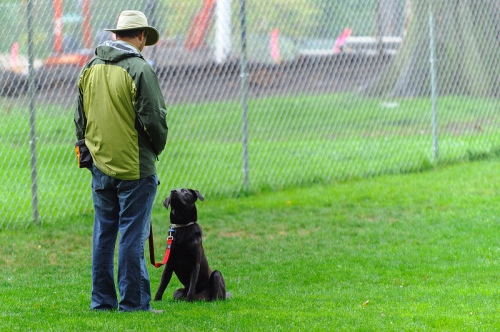Luring is sometimes frowned upon by clicker “purists,” but it can be one useful way to help a novice dog figure out what you want or to get to the end goal faster with any dog. A lure is a small reinforcer, such as a toy or treat, that is used as a “magnet” to position the dog. Many trainers use lures to teach position behaviors, such as sit, lie down, or heel. While I rarely use luring with my own dogs, I certainly think it’s a useful tool to keep in your training toolbox.
Luring is quite straightforward for both dog and handler. The dog knows right from the start what’s at stake if he can figure out what you want (whatever’s in your hand at the moment), and you can easily show your dog what to do (by using the magnetic properties of the lure). When your dog gets it right, you simply click and give your dog his reward. Easy!
As straightforward as luring can be, it can also cause some problems down the road. In the beginning stages, some dogs become too focused on the toy or treat to think about what they’re doing. Especially for food- or toy-obsessed dogs, you may find that your dog is blindly following the lure without a clue as to what behavior earned him a reward.
Another potential problem with luring is that some dogs become dependent on the lure. They become “show me the money” dogs, not performing until they know what’s at stake. This is easier to prevent than it is to fix, but it’s certainly not a deal-breaker if it happens.
Preventing lure-dependency is as simple as not letting the lure become a pattern. Use your food or toy to help the dog get into position 3-5 times, then get the reward out of your hand. Make the same hand motion you were doing with your lure, and when your dog does the target behavior, click and produce his reward from a hidden place such as a bait bag, pocket, or from behind your back. You’ve now switched from bribing the dog (showing him what he could have ahead of time) to rewarding him (surprising him with something special after he does what you want).
If your dog has already learned to wait for a lure, this is a bit trickier to work through, but still not the end of the world. In this situation, we need to reverse expectations. Many dogs learn (rightfully so!) that if you’re not holding something in your hand you’re not planning to give him anything when he complies. Your goal at this point is to change your dog’s expectation by teaching him that he’s more likely to get a reward if you don’t have anything in your hand than if you do.
Start by putting a very valuable reward in your hand and showing it to your dog. This could be a favorite toy, a hunk of roast beef, or anything else that will really get your dog excited. Ask your dog to do the behavior you’re working on. When he does, praise and pet him enthusiastically, but do not give him the reward.
Now, take that tempting reward that’s in your hand and put it away nearby where your dog can’t get it but you can still get to it quickly. Perhaps you might set it on the counter, tuck it in a bait bag, or store it on top of a nearby bookshelf. Make sure your dog sees you put it away and knows that your hand is empty. Ask for the same behavior again, and wait. Don’t repeat your cue, and don’t be surprised if it takes the dog a few moments to comply. Wait him out. At this point he’s likely to very slowly do what you asked. The second he starts to comply (before he’s even completed the behavior!), click and give him the reward (pulling it out of your bait bag, sweeping it off the bookshelf, etc). Repeat this exercise several times a day until your dog starts to get the idea that an empty hand is likely to predict great things for him. And hey, remember to be fair, okay? If you ran into this problem in the first place you were probably being a bit stingy about rewarding your dog for listening, so spend a little more time proofing that behavior before asking your dog to do it for “free” again.
Luring can certainly be a useful way to teach your dog, as long as you do so thoughtfully. Just remember to switch from luring (showing the reward to the dog ahead of time) to rewarding (producing the reward after the dog has done what you asked) quickly so you don’t become overly dependent on it.
What behaviors has your dog learned through luring? Have you ever run into any problems with this training technique? Please share your thoughts and stories in the comments below!


I taught her to heel, spin and to roll over. I haven’t had any problems because I fade my lures quickly and my dog is very smart.
Good article, I love how well informed you’re about dogs.
Right now we usually use luring as a form of management when we can’t avoid things that are just TOO exciting (hello, neighbor’s cows). To avoid lunging at those blessed bovines we lure with a ball, and must stay focused past the cows to get to play with it. It isn’t exactly like you mentioned, but keeps us from practicing bad behaviors…
What a great post, very helpful and practical Thanks.